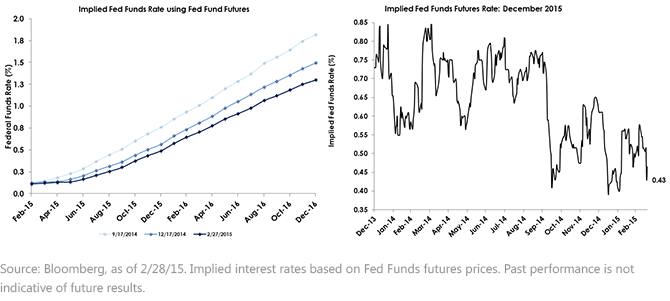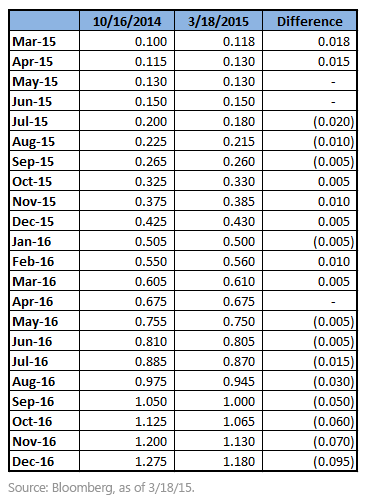Federal Funds Rate Expectations: It’s October 2014 All Over Again


 However, what is most interesting about the market’s recent reaction is that we have seen this exact market forecast before. On October 16, 2014, the shape of the Fed Funds futures curve was nearly identical to the market’s current outlook.2 In fact, as we show below, the results are within 2 basis points (bp) of one another all the way out through July 2016 (at which point the current market projections become even more bearish).
Implied Fed Funds Rate (%)
However, what is most interesting about the market’s recent reaction is that we have seen this exact market forecast before. On October 16, 2014, the shape of the Fed Funds futures curve was nearly identical to the market’s current outlook.2 In fact, as we show below, the results are within 2 basis points (bp) of one another all the way out through July 2016 (at which point the current market projections become even more bearish).
Implied Fed Funds Rate (%)
 While it would be easy to write this off as coincidence, it’s remarkable that other assets, notably U.S. stocks and bonds, have shown a dramatic divergence from this view. With many markets taking cues from the Fed, market prices appear inconsistent with the market moves over the last couple of weeks. Since October 16, the S&P 500 Index is up nearly 14%. U.S. U.S. 2- Year Treasury note yields have risen from 34 bp to 61 bp, and 10-Year rates have fallen from 2.16% to 1.93%. Interestingly, the five-year breakeven inflation rate is virtually the same for both periods (1.48% versus 1.52%).1 While the dovish tilt in the market may ultimately prove correct, if we do regain economic momentum in key data releases in the coming weeks, the market is likely to react violently to such an upward change in expectations.
This view is based on the fact that as we approach Fed tightening, the window for the market to react to such a change in policy becomes more constrained. If the Fed is going to hike rates two times before the end of the year, the futures market will need to adjust higher over a comparatively short amount of time.
In our view, while recent data may have softened compared to expectations, we believe that the economy at large has shown some meaningful signs of improvement over the last five months. However, the market is still predicting the same bearish forecast as before. As a result, investors should recall the market reaction to stronger-than-anticipated weekly jobless claims on October 16, 2014.4 Markets rallied dramatically as an upward surprise boosted Fed rate hike expectations.
We believe that the market is underestimating the likelihood of a change in Fed policy in light of a potential uptick in economic momentum. As a result, investors should continue to reduce interest rate risk in advance of any potential change in market sentiment or economic indicators.
1Source: Federal Reserve, 3/18/15.
2As of 3/19/15.
3Source: Bloomberg.
4Source: Bloomberg.
While it would be easy to write this off as coincidence, it’s remarkable that other assets, notably U.S. stocks and bonds, have shown a dramatic divergence from this view. With many markets taking cues from the Fed, market prices appear inconsistent with the market moves over the last couple of weeks. Since October 16, the S&P 500 Index is up nearly 14%. U.S. U.S. 2- Year Treasury note yields have risen from 34 bp to 61 bp, and 10-Year rates have fallen from 2.16% to 1.93%. Interestingly, the five-year breakeven inflation rate is virtually the same for both periods (1.48% versus 1.52%).1 While the dovish tilt in the market may ultimately prove correct, if we do regain economic momentum in key data releases in the coming weeks, the market is likely to react violently to such an upward change in expectations.
This view is based on the fact that as we approach Fed tightening, the window for the market to react to such a change in policy becomes more constrained. If the Fed is going to hike rates two times before the end of the year, the futures market will need to adjust higher over a comparatively short amount of time.
In our view, while recent data may have softened compared to expectations, we believe that the economy at large has shown some meaningful signs of improvement over the last five months. However, the market is still predicting the same bearish forecast as before. As a result, investors should recall the market reaction to stronger-than-anticipated weekly jobless claims on October 16, 2014.4 Markets rallied dramatically as an upward surprise boosted Fed rate hike expectations.
We believe that the market is underestimating the likelihood of a change in Fed policy in light of a potential uptick in economic momentum. As a result, investors should continue to reduce interest rate risk in advance of any potential change in market sentiment or economic indicators.
1Source: Federal Reserve, 3/18/15.
2As of 3/19/15.
3Source: Bloomberg.
4Source: Bloomberg.Important Risks Related to this Article
Fixed income investments are subject to interest rate risk; their value will normally decline as interest rates rise. In addition, when interest rates fall, income may decline. Fixed income investments are also subject to credit risk, the risk that the issuer of a bond will fail to pay interest and principal in a timely manner or that negative perceptions of the issuer’s ability to make such payments will cause the price of that bond to decline.


